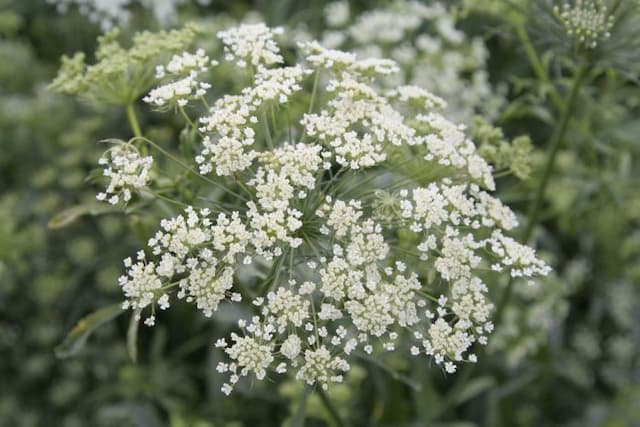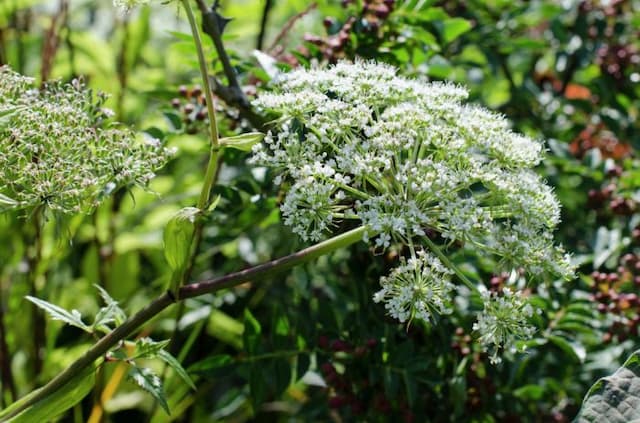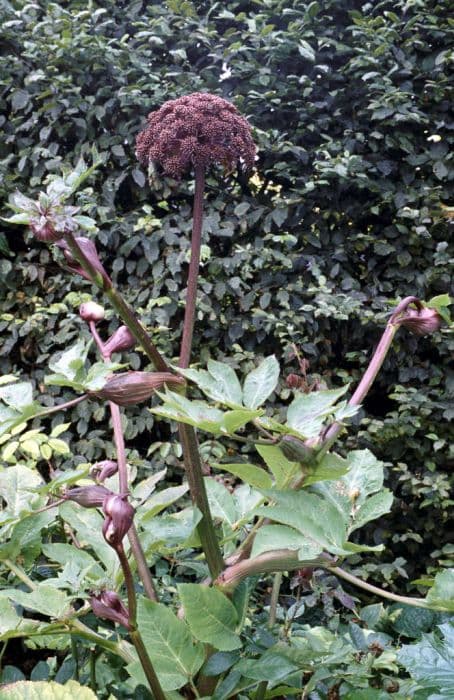Sea holly Eryngium maritimum






ABOUT
Eryngium maritimum, commonly known as sea holly, is a striking plant recognized for its unique and somewhat thistle-like appearance. This plant typically bears a rosette of basal leaves that are tough, spiny, and broadly lance-shaped with a distinctive bluish-green color, often displaying a silvery-gray hue on top. The leaves are generally veined and may feel coarse to the touch. The sea holly produces cone-shaped flower heads that are surrounded by a ruff of spiky bracts. These bracts often share the same intense blue or steel color as the leaves, although they can sometimes be more of a greenish shade. The flowers themselves are small and nestled tightly within the spiny bracts, usually appearing in a metallic blue or violet color, adding to the plant's overall charm and unusual beauty. The whole plant often exudes a slightly metallic sheen and is prized for its sculptural quality and its unique texture and coloration. It is a plant that can make a bold statement in any setting without the need for boasting about its dimensions. The sea holly, with its distinctiveness and charm, is a favorite among gardeners and floral designers alike for its ability to add a touch of the wild and whimsical to landscapes and arrangements.
About this plant
 Names
NamesFamily
Apiaceae
Synonyms
Sea Holly, Seaside Eryngo, Sea Eryngo, Sea Hulver, Marine Thistle
Common names
Eryngium maritimum var. contractum, Eryngium maritimum var. heterophyllum, Eryngium maritimum var. planum, Eryngium maritimum var. sampaianum, Eryngium planum, Eryngium simplex, Eryngium spina-alba, Eryngium spina-alba var. contractum, Eryngium spina-alba var. latifolium, Eryngium spina-alba var. oligodon, Eryngium spina-alba var. planum, Eryngium wahlenbergii, Eryngium wahlenbergii var. planum.
 Toxicity
ToxicityTo humans
Sea holly (Eryngium maritimum) is not commonly regarded as a toxic plant to humans. While there are no major reports of toxicity or poisonous effects from ingestion, as with any plant, individual allergies or sensitivities could potentially cause mild gastrointestinal discomfort or allergic reactions in some people. It is generally advised to avoid ingesting plants that are not known to be edible or that have not been traditionally used as food.
To pets
Sea holly (Eryngium maritimum) is not listed as a toxic plant to pets such as dogs and cats. There are no widely reported cases of toxicity in pets resulting from the ingestion of this plant. However, like with humans, individual pets can have varying sensitivities, and consuming non-food plants can sometimes lead to mild stomach upset. It is always a good practice to prevent pets from eating ornamental plants as a precaution.
 Characteristics
CharacteristicsLife cycle
Perennials
Foliage type
Evergreen
Color of leaves
Bluish-green
Flower color
Blue
Height
2 feet (60 cm)
Spread
1 foot (30 cm)
Plant type
Herb
Hardiness zones
5
Native area
Europe
Benefits
 General Benefits
General Benefits- Erosion control: Eryngium maritimum, commonly known as sea holly, has strong root systems that help stabilize coastal sand dunes.
- Drought resistance: It is highly tolerant of dry conditions, making it suitable for water-wise gardens.
- Wildlife habitat: The flowers provide nectar and pollen for insects, including bees and butterflies, supporting biodiversity.
- Ornamental value: Sea holly has striking flowers and unique foliage that can add architectural interest to gardens and landscapes.
- Salt tolerance: It is well adapted to saline environments, which makes it ideal for coastal landscapes.
- Culinary use: The roots were historically used as a flavoring, similar to its relative, the common culinary herb coriander.
- Adaptive to poor soils: Eryngium maritimum can thrive in poor soil conditions where other plants may struggle.
 Medical Properties
Medical Properties- Diuretic: Traditionally used to promote the production of urine.
- Anti-inflammatory: May help to reduce inflammation.
- Expectorant: Assists in the clearance of mucus from the respiratory tract.
- Diaphoretic: Can induce sweating and help to reduce fever.
- Aphrodisiac: Sometimes used to stimulate sexual desire.
- Carminative: May help to relieve flatulence.
- Antioxidant: Contains compounds that could provide antioxidant benefits.
 Air-purifying Qualities
Air-purifying QualitiesThis plant is not specifically known for air purifying qualities.
 Other Uses
Other Uses- Eryngium maritimum, also known as sea holly, has been used historically for making candy. The roots were sometimes boiled with sugar to create a sweet treat.
- The roots of sea holly have been used as a vegetable in some traditional cuisines, often prepared similarly to parsnip.
- Sea holly has ornamental value for its striking blue flowers and architectural form; it is often used in garden design and floral arrangements.
- This plant has served as a natural dye, providing a blue tint for textiles using the roots of older plants.
- The root of sea holly is used in traditional liquors and beverages, especially in a distilled form to add flavor.
- Sea holly plays a role in coastal stabilization, its deep root system can help secure sand dunes against erosion.
- Some beekeepers plant sea holly in close proximity to hives, as its flowers are a good nectar source for honeybees.
- Fishermen in some regions used sea holly as bait, particularly because of its strong scent and durability in water.
- Sea holly seed oil, while not widely used, can be extracted and is similar to safflower oil in composition.
- In some artistic practices, the unique shape of dried sea holly flowers is used in potpourri and decorative dried flower arrangements.
Interesting Facts
 Feng Shui
Feng ShuiThe plant Sea Holly is not used in Feng Shui practice.
 Zodiac Sign Compitability
Zodiac Sign CompitabilityThe plant Sea Holly is not used in astrology practice.
 Plant Symbolism
Plant Symbolism- Strength and Protection: Eryngium maritimum, commonly known as Sea Holly, is a plant with a spiny texture and rigid structure, symbolizing resilience, protection, and an ability to withstand challenging conditions, much like its natural coastal habitats.
- Attraction and Allure: With its striking blue flowers and unique appearance, Sea Holly has been associated with attraction and allure, often used in love potions and aphrodisiacs in historical folklore and tradition.
- Independence: Sea Holly thrives in sandy soils with little water, representing self-reliance, independence, and the capacity for self-sustenance.
- Nobility: The plant’s name "eryngium" is derived from a Greek word that means "to eructate," which traditionally refers to the plant’s use in ancient medicine but symbolically has been linked to regality and nobility due to its crown-like flower head appearance.
 Water
WaterSea holly, or Eryngium maritimum, should be watered moderately, as it is a drought-tolerant plant that prefers well-drained soil. During the active growing season in spring and summer, watering approximately once a week with one gallon of water per plant is sufficient, but always check the soil moisture before watering and allow the top inch of soil to dry out between waterings. During the fall and winter months, reduce watering frequency as the plant goes dormant and needs less water. Overwatering can lead to root rot, so it's crucial to ensure good drainage and avoid leaving the plant in standing water.
 Light
LightSea holly thrives in full sun conditions, requiring at least six hours of direct sunlight daily to grow healthy and produce vibrant flowers. The ideal spot for planting Eryngium maritimum would be a position where it can benefit from maximum exposure to sunlight without being shaded by taller plants or structures. If grown indoors, a south-facing window is typically the best location for achieving the necessary amount of light.
 Temperature
TemperatureSea holly prefers moderate to warm temperatures and can tolerate a range of conditions. It can survive minimum temperatures of around 0 to 10 degrees Fahrenheit, making it suitable for many temperate climates. Ideally, Eryngium maritimum enjoys temperatures between 60 and 80 degrees Fahrenheit, which promotes optimal growth. However, it is a hardy plant and can withstand slight variations outside this range.
 Pruning
PruningSea holly should be pruned to remove spent flower heads and encourage more blooms, usually done after the flowering season in late summer or fall. Pruning Eryngium maritimum promotes healthy growth and prevents the plant from becoming too leggy or sparse. Depending on the climate, it may be pruned again in late winter or early spring to remove any dead or damaged growth before new shoots appear.
 Cleaning
CleaningNot needed
 Soil
SoilSea holly thrives best in well-drained, sandy soil with a slightly alkaline pH around 7.0 to 8.5. A custom soil mix can be created using equal parts of sand, peat, and loam, or a commercial cactus mix amended with a bit of lime to increase alkalinity.
 Repotting
RepottingSea holly rarely needs repotting as it prefers to be left undisturbed once established. However, if necessary, repotting can be done in the spring every 3 to 4 years, using the same well-draining, alkaline soil mix.
 Humidity & Misting
Humidity & MistingSea holly requires low humidity levels to thrive as it is native to coastal areas. Average room humidity is typically adequate, but it prefers drier conditions similar to its natural seaside habitat.
 Suitable locations
Suitable locationsIndoor
Place sea holly in bright light, minimal watering.
Outdoor
Plant in full sun, well-draining soil, water sparingly.
Hardiness zone
5-9 USDA
 Life cycle
Life cycleEryngium maritimum, commonly known as sea holly, begins its life as a seed, shed in autumn and subject to overwintering before germination in the spring. Upon germination, the seedlings first develop a rosette of spiny, blue-green leaves at the ground level. As the plant matures, it produces one or more flowering stems that can reach up to 75 cm in height, with multiple branches bearing umbels of small, round, metallic blue flower heads surrounded by spiny bracts. These flowers are attractive to a range of pollinators, particularly bees, which help in the process of cross-pollination. After pollination, sea holly develops seed heads that contain tiny seeds, which are then dispersed by wind or water. The plant is perennial, which means it can survive for several years, going through flowering and seed-setting phases annually.
 Propogation
PropogationPropogation time
Spring to Summer
The most popular method of propagation for the Sea Holly (Eryngium maritimum) is through seed. To effectively propagate Sea Holly by seed, sow the seeds in late winter to early spring, about 1/4 inch deep (approximately 0.6 cm) in a well-draining, sandy soil mix. It's preferable to start them in a cold frame or indoors before the last frost has passed. Seeds can be slow to germinate, sometimes taking several weeks, and it is important to keep the soil consistently moist but not waterlogged during this period. Once seedlings are large enough to handle and show true leaves, they can be transplanted into individual pots and then later moved to their permanent location in the garden, taking care to not damage their deep taproots.









